Lei Yue Mun Park and Holiday Village

Lei Yue Mun Park and Holiday Village used to be Lyemun Barracks, barracks for the British Soldiers stationed in Hong Kong. It is located in the east of Shau Kei Wan, facing Lei Yue Mun, with an area of 22.97 Hectares. This is the only Holiday Village in the urban districts of Hong Kong (Hong Kong Island and Kowloon).
History
Lyemun Barracks was named after the fishing village of Lei Yue Mun. The old Lyemun Barracks was one of the earliest and most important British Army fortifications in Hong Kong. Situated at the northeast corner of Hong Kong Island overlooking the eastern approach to the Victoria Harbour, Lei Yue Mun occupied a strategic position. In 1885, the military decided to build a permanent infrastructure at Lei Yue Mun and later in 1889, the land was transferred to the War Depaertment for the construction. The Barracks comprised:
The Central Area: Main Barracks (Blocks 1-35, 48-52)
The Sai Wan Hill: Upper Fort (Sai Wan Fort)
The headland: (Lei Yue Mun Fort, now the Hong Kong Museum of Coastal Defence, Pak Sha Wan Battery (Blocks 37-46).
The fortifications of Lei Yue Mun had already become an important point of coastal defense during the 1890s and continued to expand in the following decades. By the 1930s, however, the strategic importance of Lei Yue Mun had declined considerably as a result of technological and tactical advances.
On 19th December 1941, the Barracks fell into the hands of the Japanese. At 3:00 am, a troop of Japanese soldiers, in a car, broke through the fence, using bombs and killed the British Guards. The rest of the soldiers, around 100 British soldiers, were locked in a cannon loading room, until 9:30 pm, the Japanese ordered the soldiers to get out, and shot all of the soldiers, two Chinese-British soldiers survived by hiding under the corpses, escaping successfully.
The Barracks housed the Depot and Record Office of the Hong Kong Military Service Corps between 1948 and 1986. The Barracks were handed over to the Government in 1987 and were subsequently converted into the Lei Yue Mun Park and Holiday Village.[1]
The whole former barracks compound is graded as Grade I historic building because of its historic significance. The buildings of the compound are graded as Grade I and II historic buildings separately, however.[2]
After the Lyemun Barracks were left disabled and were handed over to the Government, the Southern Part was converted into the Lei Yue Mun Park and Holiday Village, while the Northern Part was left unused and lost until it was converted into the Hong Kong Museum of Coastal Defence in 2000.
Buildings and Facilities
The Lei Yue Mun Park and Holiday Village have a total of 4 family hostels and 2 group hostels, all provided with balconies, bedrooms, and lavatories with showering facilities, it can contain the living of 282 people. It has transformed into a park/holiday village, with facilities such as rope courses, a horse-riding school (with a very steep hiking/hacking route up the nearby hillsides), tennis courts, basketball courts, football pitches, as well as many indoor games. The barracks that used to be for soldiers have been transformed into small living quarters for the holiday village.
The buildings were located across hillsides, with passageways linking them. And even though the Lyemun Barracks were converted into Lei Yue Mun Park and Holiday Village, there are still some buildings that were left deactivated and unused. An example would be Block 08, which is located behind Block 07 (The Coffee Corner).The area was listed as prohibited to enter as well. though tourists could follow a pathway behind Block 10 to reach it.
Another example would be Block 03, which is located diagonally from Block 04 (The Canteen). It was left unused and deactivated, and the area was listed as prohibited as well. Tourists must risk climbing a nearby stone slope, and over the iron wire mesh to enter. However, it is now confirmed that Block 03 will be converted into a quarantine facility, with the function to prevent epidemics from spreading in case of an outbreak.
Buildings in the holiday village have numbers printed on them to indicate which block they are, though some of these numbers may be difficult to spot. Some numbers have been printed on them long ago, during their days as part of the Lyemun Barracks. Some buildings however, have re-printed them on with a different font, or have even stripped off and removed these numbers.
Lyemun Barracks Block 01
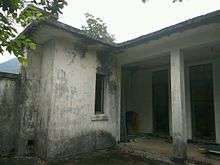
Block 01, as opposed to the other structures, has a green and white appearance, and is now isolated and left deactivated, with glass pieces and concrete scattered across the damaged building, the damage weren't too severe however. According to several signs we have discovered, with the words 'Ladies Changing Room' and 'Please Shower Before Entering The Pool.', as well as what seems to be a dried up pool right beside it, we can confirm that Block 01 was formerly used as a Changing Room for soldiers to prepare for swimming workouts. Inside, there also seems to be a small room, used for showering purposes, and large pipes that have gone rusty. Unlike the other isolated blocks mentioned above, the map pointed out that Block 01 and the swimming pool are isolated from the main barracks area and the connecting bridge, and so soldiers back in the days must use staircases to reach Block 01, in which the path was later cut off by the Island Eastern Corridor. To reach Block 01, you must climb up the staircase which is now cut in half, and climb up a steep slope along the gutter. It's recommended that you be cautious while doing so, and not to attempt when the surface is wet due to rainy weather.
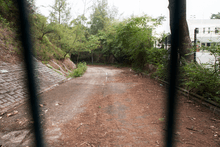
Pak Sha Wan Battery
There's a road right next to the Lei Yue Mun Public Riding School, with a locked gate preventing tourists from entering. According to the map, the road continues to stretch towards the coast, and crosses the Island Eastern Corridor as a bridge. Along the road are Blocks 37-46, and the Pak Sha Wan Battery, which were left isolated and lost from the Holiday Village. They're now claimed as property of the Hong Kong Museum of Coastal Defense. However, these places were not open to the public, and tourists would get inside themselves through various methods, either finding themselves on the bridge over the Island Eastern Corridor, or just inside the area. Along the road are leaves and tree branches that have not been removed or swept away, with a car parking gate left closed at the end of the bridge, the road then continues to the deactivated and isolated blocks of the former Lyemun Barracks.
Structures and historic buildings
The whole compound was graded as Grade I historic buildings; the historic buildings were graded separately.
The following are all structures of the former Lyemun Barracks, with some of them being Historic Buildings.[1]
Note: Block 01 is isolated from the main compound and is not open to public. Blocks 39-46 are claimed by the Hong Kong Museum of Coastal Defense and are not open to public.
Number Location Note: [Original] implies that the number was painted on by soldiers since their construction, while [Printed] implies that it was re-printed on using a different font.
| Block | Built[2] | Historic Grade[2] | Current Status | Number Location | Notes | Photographs |
|---|---|---|---|---|---|---|
| Block 01 | N/A | Isolated | Side, Top
(Shown in Bottom Photograph) [Original] |
Isolated from the Holiday Village. Formerly used as a Changing Room for soldiers before going on swimming workouts in a pool next to Block 01. | 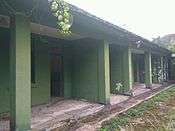  | |
| Block 02 | N/A | Demolished | N/A | Block 02 was built similarly to Block 03, with the difference of being smaller and consists of only two stories as opposed to Block 03's three. When the barracks were handed over to the government, it was decided that Block 02 would be demolished to make way for the Lei Yue Mun Public Riding School. | ||
| Block 03 | Built in 1939 | Grade III | Under Conversion | Formerly Front, Top Left (Shown in Top Photograph)
[Original] Currently Removed |
Formerly used as the Barrack Room Office or Store. It was intended to be left deactivated, but Block 03 is now confirmed to be converted into a quarantine facility. The conversion will begin in late-2017 and is expected to end in late 2019. The first photograph shows the old version, and the second photograph shows its appearance after the re-painting. | 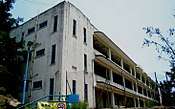 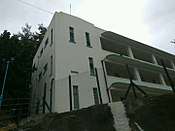 |
| Block 04 | N/A | In Use | Removed | The main building is now used as the Canteen for the Holiday Village, while providing 4 Activity Rooms as well (4A, 4B, 4C, 4D). | 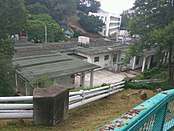 | |
| Block 05 | Built between 1920 and 1939 | Grade III | In Use | Front, Top Center (Shown in Photograph)
[Original] |
Former Gymnasium of the Barracks, now used as the Indoors Games Halls and Leisure Centers of the Holiday Village. Some people hold their weddings here due to its elegant appearance. |  |
| Block 06 | N/A | In Use | Side, Top Center (Shown in Photograph)
[Original] |
Now used as the Orchid House of the Holiday Village. | 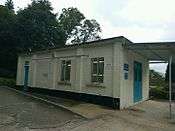 | |
| Block 6A | N/A | In Use | Front, Top Center
[Original] |
Now used as the African Violet House of the Holiday Village | 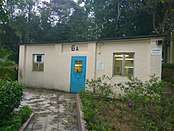 | |
| Block 07 | Built in 1890 | Grade II | In Use | Side, Top Center (Shown in Photograph)
[Original] |
Formerly used as the Officers Quarters of the Artillery Barracks, later used as the "HKMSC Training Complex", now used as the Coffee Corner of the Holiday Village. During January to July, Block 07 went under renovation and is now re-opened. Declared a monument on 20th May 2016 and is protected under the Antiquities and Monuments Ordinance along with two other blocks (Block 10 and 25). | 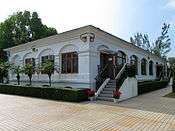 |
| Block 08 | N/A | Deactivated | Side, Top Center (Shown in Photograph)
[Original] |
Located beside Block 07, formerly used as an outhouse. Now deactivated and unused. | 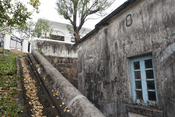 | |
| Block 09 | N/A | In Use | Front, Top Center
(Shown in Photograph) [Original] |
Now used as the Children Play House of the Holiday Village. | 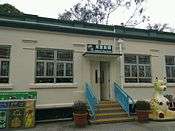 | |
| Block 10 | Built between 1890 and 1910 | Grade I | In Use | Front, Top Center
(Shown in Bottom Photograph) [Original] |
Formerly used as the Soldiers Quarters of the Artillery Barracks. Now used as the Indoor Recreational Center of the Holiday Village. Declared a monument on 20th May 2016 and is protected under the Antiquities and Monuments Ordinance along with two other blocks (Block 07 and 25). | 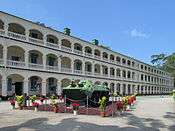 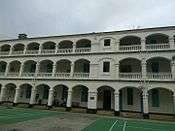 |
| Block 11 | N/A | In Use | Front, Top
(Shown in Photograph) [Printed] |
Formerly used as an outhouse. Now used as a Storage House for barbecue equipment. |  | |
| Block 12 | N/A | In Use | Behind, Top
(Shown in Photograph) [Printed] |
Formerly used as an outhouse. Now used as a Storage House for barbecue equipment. | 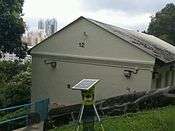 | |
| Block 13 | N/A | In Use | Front, Top
(Shown in Photograph) [Printed] |
Formerly used as an outhouse. Now used as a Latrine of the Holiday Village. | 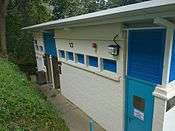 | |
| Block 14 | N/A | Demolished | Formerly used as the Married Quarters of the Barracks. | |||
| Block 15 | N/A | Not In Use | Removed | Formerly used as the Guard House of the Artillery Barracks. Later used as the ASD Property Services Branch District Management Office. Now left unused. | 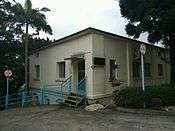 | |
| Block 16 | N/A | In Use | Front, Top (Shown in Photograph)
[Original] |
Now used as a Storage Room. | 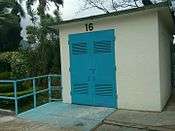 | |
| Block 17 | Built in the early 1900s | Grade III | In Use | Front, beside bridge entrance
(Shown in Bottom Photograph) [Printed] |
Formerly used as "Junior Ranks Club", now used as the Art & Craft Centre of the Holiday Village. |  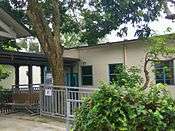 |
| Block 17A | N/A | In Use | Front, Middle
(Shown in Photograph) [Printed] |
Now used as a Storage Room. | 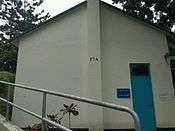 | |
| Block 18 | Built between 1890 and 1895 | Grade I | In Use | Side, Top (Shown in Bottom Photograph)
[Original] |
Now used as the Horticulture Building of the Holiday Village. | 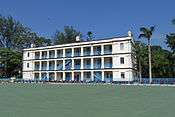 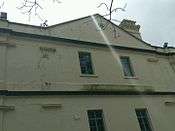 |
| Block 20 | Built between 1890 and 1895 | Grade III | In Use | Side, Top
(Shown in Photograph) [Printed] |
Now used as the Entertainment Center of the Holiday Village. | |
| Block 21 | Built between 1890 and 1895 | Grade I | In Use | Side, Top
(Shown in Photograph) [Original] |
Formerly used as H.K.M.S.C. Headquarters. Converted to the Office of the Holiday Village. | 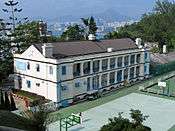 |
| Block 22 | N/A | In Use | Front Right
(Shown in Photograph) [Original] |
Now used as a Latrine and the Staff Room of the Holiday Village. | 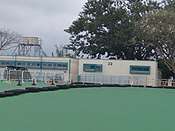 | |
| Block 23 | N/A | In Use | Front, Top Left
[Printed] |
Now used as a Flowering Garden of the Holiday Village. | 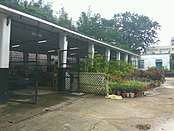 | |
| Block 25 | Built between 1884 and 1890 | Grade I | In Use | Center Right (Shown in bottom
Photograph) [Printed] |
Formerly used as Officers' Mess of the Barracks, converted to be a hostel of the Holiday Village. Declared a monument on 20th May 2016 and is protected under the Antiquities and Monuments Ordinance along with two other blocks (Block 07 and 10). | 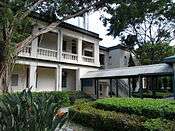 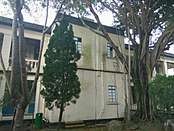 |
| Block 25A | N/A | In Use | Removed (Replaced with sign) | Now used as a Group Hostel of the Holiday Village. |  | |
| Block 26 | N/A | In Use | Right Side
(Shown in Photograph) [Printed] |
Now used as an Activity Room of the Holiday Village. | 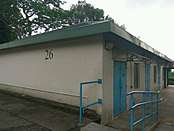 | |
| Block 28 | N/A | In Use | Formerly Front,
Top [Original] Now Front Right (Shown in Photograph) [Printed] |
Now used as a Squash Court Room of the Holiday Village. | 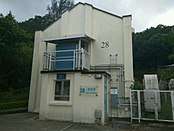 | |
| Block 29 | N/A | In Use | Right Side
(Shown in Photograph) [Printed] |
Formerly used as a vehicle garage. Now used as multiple storage rooms. | 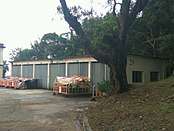 | |
| Block 30 | Built in 1936 | Grade III | In Use | Side, Top Center (Shown in Photograph)
[Original] |
"Masefield Block". Now used as a hostel of the Holiday Village. | |
| Block 31 | Built in 1907 | Grade III | In Use | Removed, presumably
under the words "Shakespeare" |
"Shakespeare Block". Now used as a hostel of the Holiday Village. | 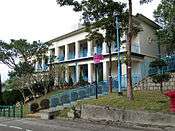 |
| Block 32 | Built in 1909 | Grade III | In Use | Side, Top,
Under the words "Tennyson" (Shown in Photograph) [Original] |
"Tennyson Block". Now used as a hostel of the Holiday Village. | 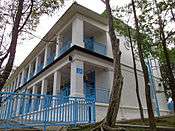 |
| Block 33 | Built in 1938 | Grade III | In Use | Removed | "Milton Block". Now used as the Staff Quarters of the Holiday Village. |  |
| Block 34 | Built in 1936 | Grade III | In Use | Removed, presumably under the words "Wordsworth" | "Wordsworth Block". Now used as a hostel of the Holiday Village. | 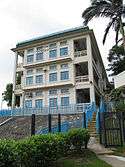 |
| Block 35 | N/A | In Use | Removed (Replaced with Sign) | Now used as an Activity Room of the Holiday Village. | 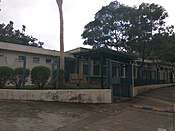 | |
| Block 37 | N/A | In Use | Front, Top Left
(Shown in Bottom Photograph) [Original] |
Now used as a Storage Room for the Hong Kong Museum of Coastal Defense, and is one of the two only blocks within the area that is currently being used. Formerly used as a Barracks room. | 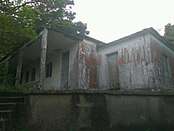
| |
| Block 38 | N/A | Deactivated | Front
(Shown in Photograph) [Original] |
Formerly used as a Latrine of the barracks, now deactivated and left unused. | 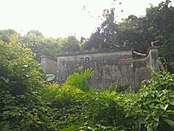 | |
| Block 39 | N/A | Deactivated | Front, Top Left
(Shown in Photograph) [Original] |
Now deactivated and left unused. Note that Block 39 and Block 40 are linked together. Formerly used as a Barracks room | 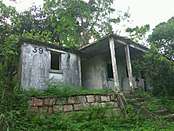 | |
| Block 40 | N/A | Deactivated | Beside Entrance
(Shown in Photograph) [Original] |
Now deactivated and left unused. Formerly used as a Barracks room along with Block 39 | 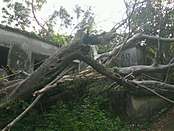 | |
| Block 41 | N/A | Deactivated | Side
(Shown in Photograph) [Original] |
Formerly used as a Showering Room of the barracks, now deactivated and left unused | 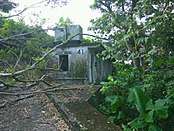 | |
| Block 42 | N/A | Deactivated | Side
(Shown in Photograph) [Original] |
Formerly used as a Latrine of the barracks, now deactivated and left unused |  | |
| Block 43 | N/A | In Use | Side
(Shown in Photograph) [Original] |
Now used as a Storage Room for the Hong Kong Museum of Coastal Defense, and is one of the two only blocks within the area that is currently being used. |  | |
| Block 44 | N/A | Deactivated | Front, Top
(Shown in Photograph) [Original] |
Now deactivated and left unused. Formerly used as a Barracks Room and a War Shelter for the Lyemun Barracks. This block is called the 'Sniper Room'. | 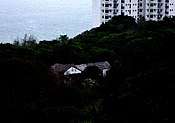 | |
| Block 45 | N/A | Deactivated | Side
(Shown in Bottom Photograph) [Original] |
Now deactivated and left unused. Formerly used as a Barracks Room. This block is called the 'Hall-Fire Room'. | 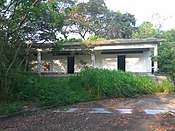 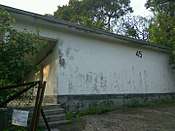 | |
| Block 46 | N/A | Deactivated | Front
(Shown in Photograph) [Original] |
Now deactivated and left unused. In front of Block 46 is what seems to be an anti-aircraft cannon which is kept in good condition. Formerly used as the 'Engine Room' for the Lyemun Barracks. | 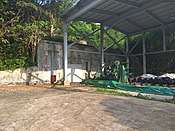 | |
| Block 48 | N/A | In Use | Front Top
(Shown in Photograph) [Original] |
Now used as a Storage Room. |  | |
| Block 49 | N/A | In Use | Beside Entrance (Shown in Photograph)
[Original] |
Now used as a Snooker Room of the Holiday Village. | 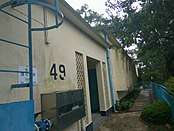 | |
| Block 50 | N/A | In Use | Left Side
(Shown in Photograph) [Original] |
Now used as a Storage Room. | 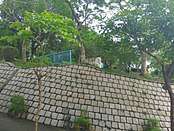 | |
| Block 52 | N/A | Deactivated | Front, Right
[Original] |
Located outside the Barracks and beside Chai Wan Road and the Park's entrance. Formerly used as the Pump Room for the Barracks. |
References
External links
| Wikimedia Commons has media related to Lei Yue Mun Park and Holiday Village. |
